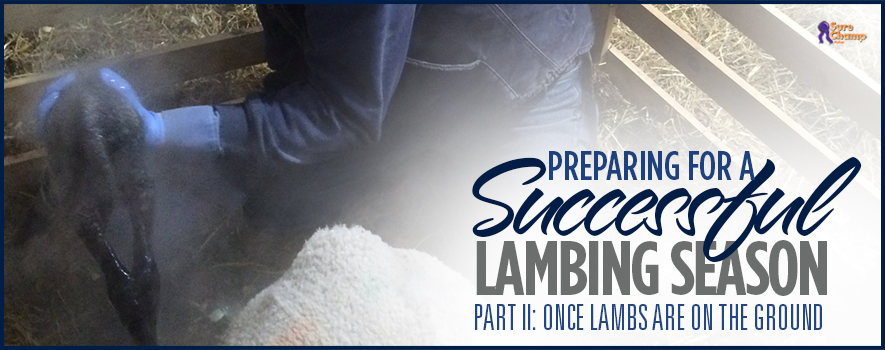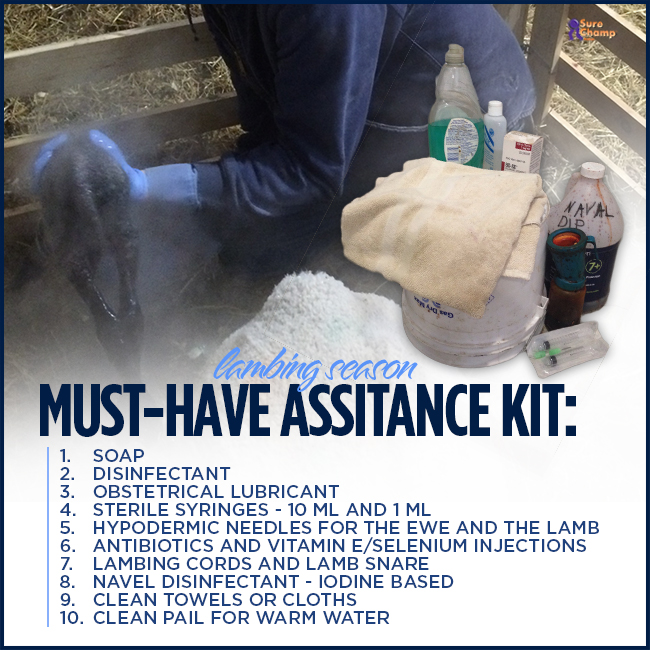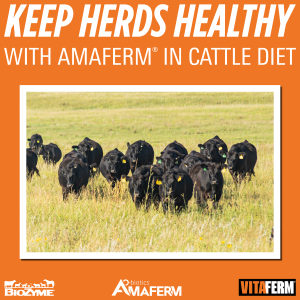
By Ben Neale
In Part I of our Preparing For a Successful Lambing series, we discussed pre and post-lambing nutrition and the importance of having the right facility set up. When lambing season begins, there are several things that you should have on hand to make sure the process goes smoothly. There are also animal health protocols that you’ll want to be thinking about.
Lambing Preparations
To be prepared for lambing you will need two kits: one to assist the ewe at lambing and the other to process each lamb as it is born.
 The Assistance Kit
The Assistance Kit
- Soap
- Disinfectant
- Obstetrical lubricant
- Sterile syringes – 10 ml and 1 ml
- Hypodermic needles of sizes suitable for the ewe and the lamb
- Antibiotics and vitamin E/selenium injections
- Lambing cords and lamb snare
- Navel disinfectant – iodine based
- Clean towels or cloths
- Clean pail for warm water
Colostrum and milk replacer should also be available. If lambing is to take place inside a building, sufficient individual pens are needed to allow each ewe in the group 2-3 days in individual housing with her lamb(s).
Lamb Processing Kit
This kit should contain:
- Suitable sized syringe and needles
- Iodine solution for dipping navels
- Vitamin E/selenium injection
- Ear tags and applicators and/or tattooing pliers
- Tail docking rings or cutter
The Lambing Process
The average gestation period for a ewe is 150 days, but some will always be early. It is important to have your ready kit well in advance so you are prepared for any early lambs.
The lamb should start breathing at birth. However, it is important to check that there is no placenta covering the nostrils or mouth. A gentle rub over the chest with a towel, or tickling the inside of the nostrils with a piece of straw or blowing into the nostrils (do not allow your lips to come in contact with the wet lamb while doing this) will often stimulate breathing.
TINT Your Lambs
In the first few days of a lamb’s life, there are several animal health procedures that should be carried out. Once you are certain that the lamb has had adequate colostrum, TINT them and Vita Charge them.
T = Tails
I = Inject
N = Navels
T = Testicles
Tails
If tail docking is going to be practiced it is recommended the tails be docked before the lamb is seven days old. The tail can be removed with:
- Electric or gas heated docker
- Rubber ring
- Crush and cut device
- Rubber ring plus crushing device.
Special attention should be given to length of tail when docked. Too short and you can create prolapse issues. If it’s left too long you will lose some of the eye and profile appeal in the show ring. In a commercial setting the docked tail should cover the anus of the ram or the vulva of the ewe. A good guide is to remove it at the joint in the tail bones just beyond the web on the underside of the tail. If you have never docked a tail before it is a good idea to consult with a veterinarian or experience producer.
Injection
In certain areas of the country, newborn lambs can be born selenium deficient. As part of your health protocol they should be injected with the appropriate dose of a vitamin E/selenium preparation. Read the label on the bottle for the recommended injection type, either subcutaneous or intramuscular. Always inject into the neck area, never into the muscles of the hindquarters.
Navels
The navel of the newborn lamb needs to be disinfected as soon after birth as possible. The untreated navel is an excellent route for infectious agents to enter the lamb causing internal abscesses or joint ill. An iodine or Nolvasan solution is the most common disinfectant used. It is either sprayed onto the navel or the navel is dipped in a small container of the solution. If dipping the navels, a good practice is to replace the disinfectant solution in the container after every tenth lamb.
Castration
If the market lambs are to be kept beyond three months of age, they need to be castrated. Again, whether rubber rings, crushing or cut and pull is used, this should be done before seven days of age. Again, if this is your first experience with castration seeking the advice of a veterinarian or more experienced producer is recommended.
Whether tattoos, ear tags or ear notching is used, the lamb should be identified before it leaves the lambing pen.
Vita Charge
The birthing process as well as tail docking and castration can be stressful on the animal. Stress has a negative impact on the digestive system and can reduce appetite. Vita Charge contains the prebiotic Amaferm that helps stimulate the bacteria and fungi in the digestive system. By giving a dose of Vita Charge prior or during stressful situation you can ensure your livestock’s appetite is maintained.
Ben Neale is a BioZyme Area Sales Manager, and has more than 15 years of experience in the livestock nutrition industry. He holds a B.S. in animal science, M.S. in agricultural operations and management, and an M.B.A., all obtained through the University of Tennessee at Martin. Ben and his wife, Lauren, run a small flock of Katahdin ewes in Tennessee, in addition to running a commercial cow/calf operation.


